 (Illustration by Taslim van Hattum)
(Illustration by Taslim van Hattum)
It is our duty to fight for our freedom.
It is our duty to win.

We must love each other and support each other.
Over the past decade, the words of Black Liberation activist Assata Shakur have echoed across California, as a chant by many grassroots youth organizing groups. It inspired them as they marched and protested as part of the Black Lives Matter movement; it inspired them as they engaged in nonpartisan campaigns to change state and local policies; and it inspired them as they worked to get out the vote. And in California, youth organizing has sparked some of the boldest systemic reforms seen in decades, including a campaign to disrupt the school-to-prison pipeline (which reduced expulsion and suspension rates in high schools statewide) and massive voter registration and education campaigns that contributed to a near tripling of youth voter turnout between 2014 and the 2018 midterm elections.
Building youth power and the infrastructure that supports it is an investment in a more equitable and just future. Drawing from both research and lived experience, we discuss what makes youth organizing groups successful in building the power to influence policy making and brighten the futures of young people of color.
Targeting Adolescents
Over the 2010s, the number of youth-organizing groups in California grew from 10-15 in 2010 to 171 by 2019. Primed by the undocumented youth movement at the beginning of the decade, and drawing energy from the allied Movement for Black Lives in the latter half, these groups engaged growing numbers of adolescents in addressing local, regional, and even statewide issues. Critical to this effort was support from The California Endowment (TCE) and other philanthropic organizations: their investment in these groups, and in intermediary organizations that support them, was crucial for expanding young people’s engagement in grassroots organizing and in the success of civic efforts that led to more than 100 policy wins and contributed to significant increases in turnout among young voters.
For example, in 2020, the student-led group Students Deserve (a TCE grantee) supported Kahlila and other teens in advocating that the Board of the Los Angeles Unified School District shift priorities away from policing and toward investments in Black student success. As a sophomore, Kahlila collapsed from dehydration at a school event. Instead of concern for Kahlila’s health, a school police officer suspected her of drug use and interrogated her. This experience motivated Kahlila to become a youth organizer, helping to establish new Students Deserve chapters across Los Angeles County and to join a campaign to defund the Los Angeles School Police Department (LASPD). That campaign, involving a coalition of youth organizing groups and other advocates, led the Los Angeles United School District board to divest $25 million from its $77 million LASPD budget and invest nearly $100 million into the Black Student Achievement Plan, which aims to keep Black and Brown students from entering the school-to-prison pipeline.
Grassroots youth organizing has garnered growing support from the philanthropic sector not only because of its efficacy and influence but also because the youth leaders of today will be the adult leaders of tomorrow. Research shows that adolescence is a uniquely adaptable stage of life, when the brain is particularly open to learning new information and when deep political interests and commitments are developed. But groups like Students Deserve also help students make sense of the political world around them and find their own voice. Grassroots youth organizing groups—many of which serve immigrant, refugee, Black, and Indigenous communities—can help participants overcome the poverty, racism, institutional injustice, and trauma they often suffer during their childhoods. By embedding young people in relationships and activities that help them constructively respond to hardships and trauma, youth organizing can channel their energy toward building a multiracial democracy.
Characteristics of Success
Research shows that members of youth organizing groups can experience a “transformative political socialization” that gives them the confidence, information, and tools they need to speak out and engage others in grassroots campaigns.
This process of socialization is catalyzed by three overlapping components:
- Attention to participants’ developmental needs, including providing social and emotional supports that address experiences with poverty and discrimination and give young people coping resources, life skills, and resilience.
- A critical civics education (often lacking in school) that helps youth engage with diverse community members, understand the root causes of community problems, and navigate public institutions.
- Guidance on civic action that teaches young people how to strategically participate in efforts to influence their world at local, regional, and societal levels.
Additionally, there are two key themes embedded in the approach of grassroots youth organizations that fully engage youth and facilitate their involvement in policy decision-making, advocacy, and narrative change efforts that are inclusive and facilitate broad impact:
1. Use of intersectional frameworks. Multiple systems of oppression based on race, class, gender, and more, affect the lives of vulnerable populations in California, and elsewhere. The concept of intersectional frameworks asserts that these systems work in concert with each other to enforce inequality. Intersectional frameworks help youth understand their circumstances as the consequences of societal-scale arrangements rather than their own failings, giving them the confidence and the motivation to challenge those arrangements. Intersectional thinking also creates inclusive programming, helping to ensure that youth groups promote equity and inclusivity in interpersonal relations, in the organizing, advocacy and campaigns in which they participate, and in the way they discuss policies, systems, and goals. Many of California’s youth organizing groups use workshops focused on the histories of different ethnic racial groups, immigration policies, gender, and LGBTQ issues to foster commitments to social justice that allow youth of color to work across racial lines and other differences. Helping young people understand power and overlapping inequalities allows them to serve as models for their elders on how to be more inclusive of people who share different backgrounds and experiences.
2. Support from intermediary organizations. Young people primarily learn how to become leaders within their local youth organizing groups. However, state-wide intermediary organizations, such as YO Cali!, Power California, Brown Issues, and PolicyLink played an important role in supporting those local groups and thereby building youth power in the 2010s. These intermediaries enhanced programming, built the capacity of organizations’ staff and young leaders, provided critical campaign support, and connected youth and organizations within and across communities, regions, and the entire state. They also disseminated information about best practices in grassroots organizing and civic engagement. Intermediaries also play a key role in rebuilding organizational capacity in the wake of the pandemic, and as grassroots youth organizing groups emerge in new regions with limited civic infrastructure.
 (Illustration by Taslim van Hattum)
(Illustration by Taslim van Hattum)
The organization Students Deserve embodies the characteristics that make youth groups successful. It teaches students about the school-to-prison pipeline, restorative justice, and the history of policing. It provides students with information, such as the fact that Black students make up only 8 percent of the Los Angeles school population but represent 25 percent of school police citations, diversions, and arrests. This knowledge helped Kahlila place her personal experience with campus police as part of larger pattern of bias and oppression. Students Deserve members, including teachers and community organizers, helped Kahlila hone and practice speeches about this experience that she presented to the school board as part of the campaign to defund school police.
The Lasting Implications of Investments in Youth Organizing
Now an alumna of Students Deserve and a rising junior at UCLA, Kahlila helps train a new wave of young leaders through Students Deserve, teaching workshops on the history of race and criminalization, the labor movement, and power mapping, and training students in advocacy and voter registration skills. As part of the California Freedom Summer Participatory Action Research Project, she also worked to register young voters, putting into action her belief that engagement in the electoral process can complement and amplify the grassroots efforts of youth. In this way, youth organizing helps build the future.
The grassroots youth organizing of the 2010s offers important lessons for building power among youth most impacted by pressing social inequalities. The investments the philanthropic community made in youth and youth organizing in the 2010s will have a lasting influence on communities across California. Many of the young leaders of the past decade will continue to work to improve the health and well-being of residents in the years ahead and some will serve as mentors for the next generation of youth leaders. Youth organizing has won reforms, taught philanthropy important lessons about inclusive civic engagement, and informed intergenerational efforts to address health and related inequalities. In short, investing in activities, programming, and infrastructure that support power building among young people will expand the pool of diverse leaders committed to equity and a more representative democracy.
Support SSIR’s coverage of cross-sector solutions to global challenges.
Help us further the reach of innovative ideas. Donate today.
Read more stories by Veronica Terriquez & Kahlila Williams.

